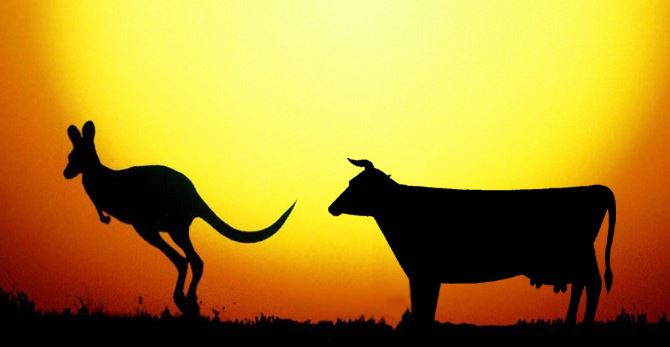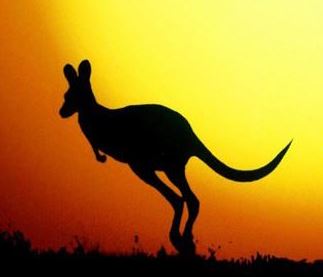A kangaroo flatulence study, i.e. a study of kangaroo farts, has turned previous research on its head. Scientists from Australia and Switzerland say that what determines how much methane is blown off is determined by how rapidly the food goes through their gut, rather than what type of microorganisms exist in the animals’ digestive tract.
The researchers, who published their findings in The Journal of Experimental Biology, say theirs is the most comprehensive study so far on methane emissions from Australia’s largest marsupials.
Scientists have long been arguing about how much methane in the atmosphere comes from kangaroos. Now, we have a better idea, thanks to research led by Dr. Adam Munn, who works at the Institute for Sustainable Ecosystem Solutions at University of Wollongong, and Professor Marcus Clauss, from the Clinic of Zoo Animals, Exotic Pets and Wildlife in Zurich, Switzerland.
 Why do kangaroos emit less methane than cows (after factoring in weight)?
Why do kangaroos emit less methane than cows (after factoring in weight)?
The research was performed by PhD student and veterinarian, Catharina Vendl, who works at the Fowlers Gap Arid Zone Research Centre at the University of New South Wales.
“We knew that the kangaroos would produce little methane, but certainly not zero, and the question remained as to why.”
Animals, such as cattle, release methane (CH4) into the atmosphere, which contributes to global warming. A 2009 study found that at least 51% of global greenhouse gas emissions come from raising farm animals and getting their produce into the shops and then into people’s homes.
Study contradicts previous research
Dr. Munn said:
“The main hypotheses behind kangaroos producing little methane have focused on kangaroos having a unique microbiome that produces less methane, mainly from flatulence rather than burping like cows and sheep. But, without wanting to burst the bubble of the microbiologists, our findings suggest otherwise.”
Dr. Munn and colleagues measured absolute kangaroo output, and compared it to that of horses. They also factored in body weight.
Prof. Clauss commented:
“Kangaroos have a very different stomach from that of ruminants such as sheep and cows. We think that the methane is low because of the way food moves through the kangaroo stomach, and not because of a unique gut fauna.”
The researchers found that the amount of methane released per ingested food varies, even for kangaroos, and depends on how much they consume.
With a typical kangaroo diet, the food goes through their gut much more quickly (compared with ruminants). This means they produce less methane.
The gut fauna approach will fail
When the researchers fed the kangaroos restrictively, their methane production was almost as high as in some animals, such as cattle.
Scientists who want to try to reduce greenhouse gas emissions from ruminant livestock by replacing their gut fauna with kangaroo gut fauna are going about it the wrong way, Dr. Munn and Prof. Clauss warn. This approach will fail, they believe.
This latest study’s findings add to the team’s research into wildlife methane emissions that tries to determine what the rules of methane production are by monitoring several different species.
So far, Prof. Clauss and Dr. Munn and team have monitored and measured methane emissions from camels, rabbits, rodents, horses, rheas, emus, ostriches, kangaroos, sloths, and llamas.
They say additional studies are needed to fully understand why so many of these animals emit lower quantities of methane compared to cattle and other ruminants.
The authors wrote in an Abstract in the journal:
“Although our data suggest that kangaroos only produce about 27% of the body mass-specific volume of CH4 of ruminants, it remains to be modelled with species-specific growth rates and production conditions whether or not significantly lower CH4 amounts are emitted per kg of meat in kangaroo than in beef or mutton production.”
Reference: “Decreasing methane yield with increasing food intake keeps daily methane emissions constant in two foregut fermenting marsupials, the western grey kangaroo and red kangaroo,” Catharina Vendl, Michael Kreuzer, Jürgen Hummel, Marcus Clauss, Mathew Stewart, Keith Leggett & Adam Munn. Journal of Experimental Biology. November 2015. DOI: 10.1242/jeb.128165.
Video – Study on kangaroo gas emissions


Comments are closed.